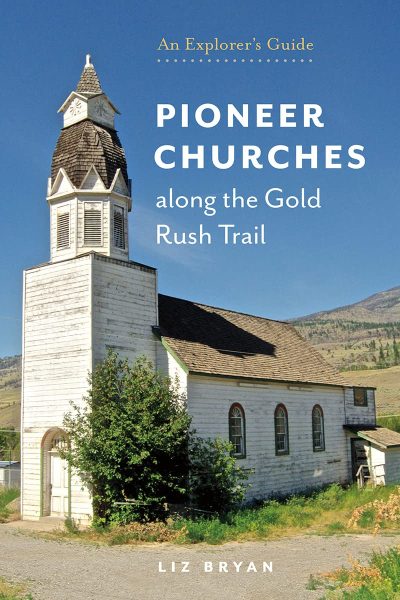
Pioneer Churches along the Gold Rush Trail: An Explorer’s Guide
Review By Patricia E. Roy
January 2, 2024
BC Studies no. 219 Autumn 2023 | p. 137-139
British Columbia may have been Canada’s least religious province in the late nineteenth and early twentieth centuries but religion was present.1 The built heritage, illustrated and described in Pioneer Churches along the Gold Rush Trail: An Explorer’s Guide, demonstrates that several Christian faiths served settlers and acted as missionaries to the Indigenous peoples. Because it is an Explorer’s Guide, the book opens with an attractive map showing the general location of each church. Each short “chapter” is devoted to a particular church and follows a similar pattern: a brief history of the origins of the church with an anecdote or two; a description of its architectural features (a major consideration for inclusion) and a comment on its current status. When necessary, telephone numbers for information about access are provided as well as explanations of routes to churches off the main roads. The author’s brilliant coloured photographs and a few historical ones complement the prose. A glossary of religious and architectural terms, suggestions for further reading, and a useful index make Pioneer Churches reader-friendly.
The trip begins in New Westminster, the headquarters of the Royal Engineers who built two Anglican churches there: Holy Trinity which has been twice replaced because of fire and St. Mary the Virgin which survives. The pioneer Presbyterian church remains as the church hall so is included but the Methodist and Catholic churches did not survive the city’s 1898 fire so are not. Apart from side trips on the Douglas Trail from Pemberton to Lillooet and into the Nicola Valley, the journey continues inland and north along the route of the old Cariboo wagon road to Barkerville.
At a distance many churches appear to have come from the same Carpenter Gothic plan book but Bryan points out that creative builders added unique features particularly in bell towers. The interiors vary greatly. Some are very plain; others show considerable artistry. Carpenters placed boards diagonally around a heart to create a halo effect above the altar of St. Louis on the Bonaparte First Nations. What may be Bryan’s favourite church, the Church of the Holy Cross built in 1905 at Skatin on the Lillooet River, is now only accessible by a logging road from Mount Currie. Its three tall spires may have been inspired by postcards of French cathedrals. Inside, the focal point is an elaborate altar and reredos (altar screens) decorated with stars, fleur-de-lys, crosses, and fancy borders painted in gold. Local Indigenous carpenters and artists made all but the stained glass windows. It has had repairs, but in 2021, Bryan noticed some deterioration. Despite its isolation, it would be a shame if this “stunning” church, a National Historic Site, were allowed to disappear.
Some historic churches have been well-maintained and still host regular services. What Bryan describes as “one of the prettiest churches” on the Cariboo Road, the Church of the Immaculate Conception on the Sugar Cane Reserve has been renovated without affecting its original charm. Some buildings have survived because they were moved. St. Mark’s Anglican Church became redundant after the route to the Cariboo by-passed Port Douglas. When settlers moved into the Chilliwack area, Bishop George Hills gave them the church for the cost of moving it. As Chilliwack grew, the building, renamed St. Thomas, was expanded and moved to another site in Chilliwack. Other churches have been repurposed. At Yale, the original Royal Engineers’ church is part of a museum complex. The Lillooet Museum’s stained glass window recalls its former role as an Anglican church.
Alas, some structures have completely disappeared, often through fire as in the recent case of the Anglican and Catholic churches at Lytton which, fortunately, Bryan had already photographed. Many abandoned buildings are in various states of disrepair. At Tsalath, according to custom, the Indigenous community is deliberately letting St. Mary’s go back into the earth.
The high proportion of Anglican churches speaks to the strong British influence and of Roman Catholic churches, to the missionary endeavours of that faith. Yet, like the Anglicans, Catholic settlers built churches and like the Catholics, Anglicans had missions. Bryan provides examples of both. Presbyterians and Methodists only get passing mention likely because their missionary work focused on the coast and perhaps because their churches were less architecturally interesting.
While of obvious interest to architectural historians, Pioneer Churches also invites questions. Missionaries built many of the now abandoned churches as part of their work among the Indigenous people but in some cases, the church seems to be the only evidence of a human presence. What happened to the people? St. Aidan’s, between Spence’s Bridge and Ashcroft, for example, was built in the 1880s, well after smallpox, the major cause of depopulation, swept through the area. Or, did missionaries believe that a centrally located church would attract worshippers?
The Gold Rush Trail book is Bryan’s second book on historic churches in BC.2 One hopes that she will look at more regions of the province. These handsome volumes are a fine introduction to aspects of British Columbia history both for armchair travellers and explorers.
1 Lynne Marks, Infidels and the Damn Churches: Irreligion and Religion in Settler British Columbia (Vancouver: UBC Press, 2017), 4.
2 The first volume was Pioneer Churches of Vancouver Island and the Salish Sea ([Victoria: Heritage House, 2020).
Publication Information
Bryan, Liz. Pioneer Churches along the Gold Rush Trail: An Explorer’s Guide. Victoria: Heritage House Publishing. 2022. 224 pp. $24.95 paper.
